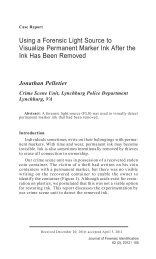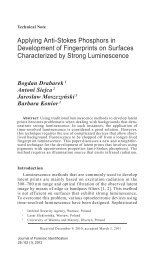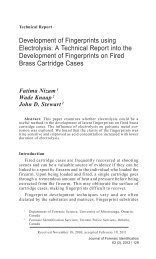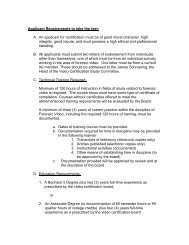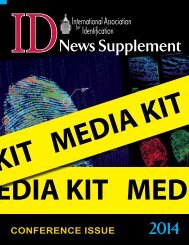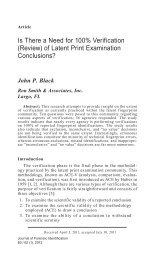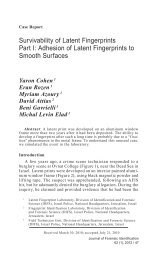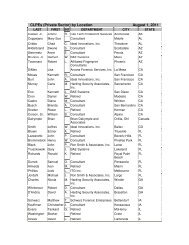Bromophenol Blue as a Chemical Enhancement Technique for ...
Bromophenol Blue as a Chemical Enhancement Technique for ...
Bromophenol Blue as a Chemical Enhancement Technique for ...
Create successful ePaper yourself
Turn your PDF publications into a flip-book with our unique Google optimized e-Paper software.
Technical Note<br />
<strong>Bromophenol</strong> <strong>Blue</strong> <strong>as</strong> a <strong>Chemical</strong><br />
<strong>Enhancement</strong> <strong>Technique</strong> <strong>for</strong> Latent<br />
Shoeprints<br />
Katelyn McNeil 1<br />
Wade Knaap 2<br />
Abstract: The enhancement of two-dimensional shoe impressions,<br />
where the matrix is soil, may best be approached using chemistry.<br />
Pot<strong>as</strong>sium thiocyanate, which reacts with iron particles in soil, is a<br />
generally accepted development medium used by <strong>for</strong>ensic investigators.<br />
<strong>Bromophenol</strong> blue, a pH indicator that reacts with carbonates in<br />
soil, is used, but with less frequency, particularly in North America.<br />
This study compared both chemistries and their ability to enhance<br />
two-dimensional shoe impressions deposited from a variety of soil<br />
samples on varying substrates. <strong>Bromophenol</strong> blue, although determined<br />
to be an inappropriate enhancement technique <strong>for</strong> brown paper<br />
samples, provided significantly more detailed enhancement than pot<strong>as</strong>sium<br />
thiocyanate with other tested substrates, including pl<strong>as</strong>tic and<br />
linoleum.<br />
Introduction<br />
The documentation and preservation of two-dimensional<br />
shoeprint impressions can be difficult. Impressions can be left in<br />
various substances (e.g., dust, blood, mud), which makes details<br />
difficult to detect. Be<strong>for</strong>e a shoeprint can be processed, it must<br />
be photographed, but often this photograph lacks sufficient<br />
contr<strong>as</strong>t. <strong>Chemical</strong> enhancement techniques provide incre<strong>as</strong>ed<br />
contr<strong>as</strong>t between the shoeprint and the background, allowing<br />
photographs to document more detail. These enhancement<br />
techniques can be valuable, but there is little research available<br />
to <strong>as</strong>sess their effectiveness.<br />
1 University of Toronto Mississauga, Ontario, Canada<br />
2 Forensic Identification Services, Toronto Police Services, Ontario,<br />
Canada<br />
Received December 13, 2010; accepted April 12, 2011<br />
Journal of Forensic Identification<br />
62 (2), 2012 \ 143
Pot<strong>as</strong>sium thiocyanate w<strong>as</strong> first introduced in the United<br />
States in 1994 [1]. Someha acknowledged Junichi Murao <strong>as</strong> the<br />
individual who developed the technique in 1957. This technique<br />
is regarded <strong>as</strong> the most effective chemical enhancement<br />
technique <strong>for</strong> dusty and muddy footwear impressions regardless<br />
of the substrate on which it is deposited [2]. Pot<strong>as</strong>sium thiocyanate,<br />
routinely used by the Ontario Provincial Police, reacts<br />
with metal ions in soil, particularly iron, to cause a bright red<br />
coloration, depending on ferric ion concentration in the soil [3].<br />
<strong>Bromophenol</strong> blue, developed <strong>as</strong> a <strong>for</strong>ensic identification<br />
technique in 1996, h<strong>as</strong> been used with great success in Israel<br />
<strong>as</strong> a chemical enhancement technique [4]. <strong>Bromophenol</strong> blue<br />
is a pH indicator with a transition range of pH 3 to 4.6. In the<br />
acidic <strong>for</strong>m, it appears yellow and in the b<strong>as</strong>ic <strong>for</strong>m, it appears<br />
blue. The enhancement of bromophenol blue can be improved<br />
by applying steam [4]. <strong>Bromophenol</strong> blue reacts with carbonates<br />
in the soil [4] <strong>as</strong> well <strong>as</strong> with amino acids [3] and h<strong>as</strong> been<br />
found to be more effective than other chemical enhancement<br />
techniques when calcium carbonate is a major component in the<br />
soil [5]. Other studies have used gel lifters to recover shoeprints<br />
and have then treated them with bromophenol blue. Because<br />
the white adhesive lifter provides better contr<strong>as</strong>t between the<br />
background and developed impression, it is e<strong>as</strong>ier to apply vapor<br />
directly after if required, and this removes the issue of enhancement<br />
of the background <strong>as</strong> well [5].<br />
The aim of the current study is to <strong>as</strong>sess the usefulness of<br />
bromophenol blue on soils from several locations in Ontario,<br />
Canada. Also, the present study examines the enhancement<br />
abilities of bromophenol blue and compares them to pot<strong>as</strong>sium<br />
thiocyanate. It is hypothesized that bromophenol blue is<br />
an effective chemical enhancer <strong>for</strong> soil shoeprint deposit. The<br />
enhancement chemistries – bromophenol blue and pot<strong>as</strong>sium<br />
thiocyanate – were tested on various soil samples and substrates.<br />
Method<br />
Ten soil samples were collected from several locations<br />
throughout southern Ontario to allow <strong>for</strong> comparison: Ottawa,<br />
Mississauga, Brampton, Scarborough, Port Perry, Oak Ridges,<br />
and four are<strong>as</strong> in Toronto (Lakeshore at Sunnyside Park; St Clair<br />
Avenue West and Keele Street; Toronto Iron Works at E<strong>as</strong>tern<br />
Avenue and Caroline Avenue; and banks of the Don River). The<br />
soil samples were all placed in separate cardboard hand-gun<br />
boxes, air-dried, and broken into smaller dustlike particles.<br />
Journal of Forensic Identification<br />
144 / 62 (2), 2012
The left shoe of a pair of size 8 women’s Sketcher shoes<br />
w<strong>as</strong> used to make all shoe impressions. Individual characteristics<br />
were created by the researcher by cutting the outsole and<br />
by the insertion of a thumb tack. For comparison purposes, a<br />
control shoeprint (Figure 1) w<strong>as</strong> created by dusting a gre<strong>as</strong>y<br />
shoeprint impression with black magnetic fingerprint powder.<br />
The enhanced impression w<strong>as</strong> then analyzed, with eight individualizing<br />
characteristics being noted. The control print w<strong>as</strong> then<br />
copied onto an acetate overlay. For all test impressions, the same<br />
individual (wearer) deposited each impression with a similar<br />
stepping technique (i.e., rolling from heel to toe) and application<br />
<strong>for</strong>ce to provide replication consistency. Experimental impressions<br />
were made by stepping into a hand-gun box containing a<br />
sample soil collection. Excess soil w<strong>as</strong> shaken off of the outsole<br />
prior to stepping on each substrate. All experimental impressions<br />
were deposited in the same f<strong>as</strong>hion <strong>as</strong> to approximate a realistic<br />
walking pattern. All impressions were photographed be<strong>for</strong>e<br />
enhancement using lighting techniques to capture maximal<br />
detail. This w<strong>as</strong> completed to ensure that there were no significant<br />
differences in detail in the latent shoeprint impressions. If<br />
experimental impressions were smudged or had an otherwise<br />
inappropriate level of detail, impressions were excluded from<br />
the study be<strong>for</strong>e treatment with enhancement chemistries.<br />
Figure 1<br />
Control shoeprint with the eight individual characteristics identified.<br />
Journal of Forensic Identification<br />
62 (2), 2012 \ 145
Impressions on brown paper were photographed using<br />
overhead f luorescent lighting; impressions on pl<strong>as</strong>tic and on<br />
linoleum were photographed with oblique white light generated<br />
from a Luma-Lite (Payton Scientific Inc., Buffalo, NY). For<br />
brown paper and pl<strong>as</strong>tic substrate samples, six impressions were<br />
made, where<strong>as</strong> only four impressions were made on linoleum.<br />
Half of the impressions were sprayed with bromophenol blue<br />
and the other half were sprayed with pot<strong>as</strong>sium thiocyanate.<br />
All enhanced prints were photographed. Prints enhanced with<br />
bromophenol blue were steamed <strong>for</strong> maximal contr<strong>as</strong>t and then<br />
re-photographed. This technique added extra moisture to the soil<br />
so that the enhancement could occur.<br />
Both of the enhancement chemistries were prepared at the<br />
Toronto Police Forensic Identification unit. To make pot<strong>as</strong>sium<br />
thiocyanate, 15 g of pot<strong>as</strong>sium thiocyanate (Alphachem Ltd.<br />
Mississauga, Ontario) w<strong>as</strong> added to 120 mL of acetone and 15<br />
mL of water. In a separate beaker, 1 mL of concentrated sulfuric<br />
acid w<strong>as</strong> added to 9 mL of water. Upon mixing the dilute acid<br />
and pot<strong>as</strong>sium thiocyanate mixture, a solute <strong>for</strong>med. Once the<br />
solute settled, an eye dropper w<strong>as</strong> used to transfer the top layer<br />
to a spray bottle. For the purposes of this study, a fine mist w<strong>as</strong><br />
necessary to be produced. To generate this spray, the Kitchen<br />
Spritzer (Pampered Chef, Addision IL) w<strong>as</strong> used (Figure 2).<br />
This spray bottle uses a hand pump to create pressure so that a<br />
fine mist can be generated. The bottle w<strong>as</strong> pumped until there<br />
w<strong>as</strong> resistance against the pumping (approximately three full<br />
pumps). A small amount of mist w<strong>as</strong> rele<strong>as</strong>ed be<strong>for</strong>e being<br />
sprayed onto the experimental impressions. The bromophenol<br />
blue (Alphachem Ltd. Mississauga, Ontario) w<strong>as</strong> prepared using<br />
<strong>as</strong> a solution of 1% (w/v) bromophenol blue in a solution of 5%<br />
water in methanol.<br />
For the analysis of the experimental prints, the acetate<br />
overlay w<strong>as</strong> used to make pointwise comparisons on a four-point<br />
scale: 0 to 3. A score of 0 w<strong>as</strong> used to denote the absence of the<br />
individual characteristic or if the enhancement obscured the<br />
detail, and 1 w<strong>as</strong> used to denote the presence of the individual<br />
characteristic but that it lacked identifying detail. Both 0 and<br />
1 lacked sufficient detail to make an identification and were<br />
cl<strong>as</strong>sed <strong>as</strong> nonconclusive. A score of 2 w<strong>as</strong> used when the<br />
individual characteristic w<strong>as</strong> present and defined, and a score<br />
of 3 w<strong>as</strong> <strong>as</strong>signed when individual characteristics were present,<br />
well defined, and showed clear enhancement. Both a 2 and a 3<br />
had sufficient detail <strong>for</strong> an identification to be made. A paired<br />
t-test w<strong>as</strong> used to test the means of between nonconclusive and<br />
Journal of Forensic Identification<br />
146 / 62 (2), 2012
Figure 2<br />
Kitchen Spritzer.<br />
identification between pot<strong>as</strong>sium thiocyanate and bromophenol<br />
blue. For the t-test, a score of 0 or 1 w<strong>as</strong> given a score of 0, and<br />
a score of 2 or 3 w<strong>as</strong> given a score of 1 <strong>for</strong> statistical purposes.<br />
Qualitative observations were also made about the level<br />
of enhancement. Because of the nature of the enhancement<br />
techniques, they may not have worked on all of the soil types. A<br />
cl<strong>as</strong>sification of “enhanced” or “did not react” w<strong>as</strong> made with<br />
each soil type <strong>for</strong> each enhancement method (pot<strong>as</strong>sium thiocyanate<br />
and bromophenol blue). A scale from -1 to 3 w<strong>as</strong> used to<br />
<strong>as</strong>sess the enhancement. A score of -1 w<strong>as</strong> given if there w<strong>as</strong><br />
a deterioration of the print (e.g., the enhancement chemistry<br />
reacted with the substrate, obscuring the detail of the shoeprint<br />
impression). A score of 0 w<strong>as</strong> given when the print w<strong>as</strong> not<br />
enhanced (e.g., the shoeprint impression appeared the same<br />
be<strong>for</strong>e and after the enhancement chemistry w<strong>as</strong> applied). A<br />
score of 1 w<strong>as</strong> given <strong>for</strong> a somewhat enhanced shoeprint impression<br />
(e.g., the chemistry reacted with the soil but resulted in<br />
limited enhancement). A score of 2 w<strong>as</strong> given when the shoeprint<br />
impression w<strong>as</strong> enhanced (e.g., there w<strong>as</strong> contr<strong>as</strong>t between the<br />
background and the enhanced shoeprint impression). A score of<br />
3 w<strong>as</strong> given when the print w<strong>as</strong> very much enhanced (e.g., there<br />
w<strong>as</strong> very strong, clear, distinct enhancement of the shoeprint<br />
impression). Also, because of the nature of the substrates, a<br />
judgment about whether the enhancement technique w<strong>as</strong> appro-<br />
Journal of Forensic Identification<br />
62 (2), 2012 \ 147
priate also w<strong>as</strong> made. For the bromophenol blue, the substrate<br />
w<strong>as</strong> deemed to be acceptable if the background turned yellow<br />
and the soil turned blue, but if the background turned blue, then<br />
it w<strong>as</strong> unsuitable. For pot<strong>as</strong>sium thiocyanate, if the soil turned a<br />
red to pink color and the background did not turn significantly<br />
red to pink, then it w<strong>as</strong> considered to be appropriate <strong>for</strong> the<br />
substrate. Also, any particular characteristics or interactions<br />
between liquid and substrate were also noted.<br />
Results and Discussion<br />
Both bromophenol blue and pot<strong>as</strong>sium thiocyanate reacted<br />
with all of the soil samples from the Toronto are<strong>as</strong>. <strong>Bromophenol</strong><br />
blue reacted with the brown paper substrate, causing the brown<br />
paper to turn blue, which obscured the footwear impression. It<br />
h<strong>as</strong> been previously noted that a <strong>for</strong>mulation of bromophenol<br />
blue that consists of too much water can cause the background to<br />
enhance [4]. Perhaps a different <strong>for</strong>mulation of bromophenol blue<br />
would be effective in enhancing shoeprints on paper samples,<br />
though it is noted that white paper h<strong>as</strong> previously been found to<br />
react [4]. Also, the steaming step of the enhancement of bromophenol<br />
blue may be unnecessary in humid climates because it<br />
introduces extra moisture, which may cause it to overreact. The<br />
soil samples in the present study lacked moisture and, <strong>as</strong> a result,<br />
adding extra moisture benefited the enhancement, but often the<br />
samples reacted be<strong>for</strong>e the steam w<strong>as</strong> applied. <strong>Bromophenol</strong> blue<br />
used on the pl<strong>as</strong>tic and on the linoleum ranged from “somewhat<br />
enhanced” to “very much enhanced”, where<strong>as</strong> when it w<strong>as</strong> used<br />
on brown paper, there w<strong>as</strong> a deterioration of detail. Pot<strong>as</strong>sium<br />
thiocyanate w<strong>as</strong> effective at enhancing all substrates tested, but<br />
it tended to have a weaker contr<strong>as</strong>t compared to bromophenol<br />
blue. Pot<strong>as</strong>sium thiocyanate ranged from a level of “unaltered”<br />
to a level of “very much enhanced” but often gave minimal<br />
enhancement. Table 1 lists the qualitative ratings of level of<br />
enhancement. Although qualitative analysis is subjective and<br />
different conclusions can be drawn even among experts [6],<br />
the trend of bromophenol blue having a stronger enhancement<br />
contr<strong>as</strong>t is evident.<br />
Journal of Forensic Identification<br />
148 / 62 (2), 2012
<strong>Bromophenol</strong> <strong>Blue</strong> Pot<strong>as</strong>sium Thiocyanate<br />
Soil Paper Pl<strong>as</strong>tic Linoleum Paper Pl<strong>as</strong>tic Linoleum<br />
St Clair and Keele 0.67 2.5 2 1.67 2 0.5<br />
Don River 0.33 2.67 1.5 1.33 1.67 0.5<br />
Toronto Iron Works -1 1.33 1 1 1 1<br />
Port Perry -1 2 1.5 1.67 1 1<br />
Scarborough -1 1.67 2 1.33 1.33 1<br />
Ottawa -1 1.33 1 1.33 1.67 1<br />
Lakeshore -1 2 1 2 2 1<br />
Mississauga -1 1.67 1.5 2.33 1.67 1<br />
Oak Ridges -1 1.33 1.5 1.67 2 2.5<br />
Brampton -1 1 1 1.33 1 1<br />
Average -0.7 1.75 1.4 1.67 1.53 1.05<br />
Table 1<br />
Average qualitative ratings of level of enhancement.<br />
From paired t-test analyses it w<strong>as</strong> found that when all of the<br />
substrates were considered, the levels of enhancement of bromophenol<br />
blue and pot<strong>as</strong>sium thiocyanate were not significantly<br />
different [t(78) = 0.49, P < 0.622], but when the brown paper<br />
w<strong>as</strong> excluded, bromophenol blue enhanced individual details<br />
significantly better than pot<strong>as</strong>sium thiocyanate [t(47) = 4.78, P<br />
< 0.001].<br />
When analyzing specific substrates, pot<strong>as</strong>sium thiocyanate<br />
enhanced detail significantly better than bromophenol blue on<br />
brown paper [t(28) = 7.29, P < 0.001], but bromophenol blue had<br />
a significantly higher level of detailed enhancement than pot<strong>as</strong>sium<br />
thiocyanate on linoleum [t(19) = 3.09, P < 0.006] and pl<strong>as</strong>tic<br />
[t(26) = 4.27, P < 0.001]. Pl<strong>as</strong>tic gave the best level of detail<br />
<strong>for</strong> both bromophenol blue and pot<strong>as</strong>sium thiocyanate, where<strong>as</strong><br />
the enhancement of latent shoeprints on brown paper treated<br />
with bromophenol blue had the lowest level of enhancement.<br />
These results are depicted in Figure 3. Overall, bromophenol<br />
blue had more three-point enhancements, identifying level of<br />
detail, than the pot<strong>as</strong>sium thiocyanate. See Figure 4 and Figure 5<br />
<strong>for</strong> examples of enhancement on the pl<strong>as</strong>tic substrate using the<br />
same soil sample with bromophenol blue and with pot<strong>as</strong>sium<br />
thiocyanate, respectively.<br />
An analysis of individual detail enhancement of each of the<br />
soils w<strong>as</strong> also conducted. The level of enhancement of individual<br />
detail from the pointwise comparisons w<strong>as</strong> not significantly<br />
different between soils from Mississauga, Lakeshore, Ottawa,<br />
Brampton, Don River, St Clair Avenue and Keele Street, and<br />
Toronto Iron Works even when the overenhanced paper samples<br />
treated with bromophenol blue were removed from the analy-<br />
Journal of Forensic Identification<br />
62 (2), 2012 \ 149
sis. Pot<strong>as</strong>sium thiocyanate had a significantly higher level of<br />
individual detail enhancement on the pointwise comparison than<br />
bromophenol blue [t(7) = 2.45, P < 0.05] <strong>for</strong> the Oak Ridges soil.<br />
When the overenhanced bromophenol blue on paper samples<br />
were removed from the analysis, bromophenol blue and pot<strong>as</strong>sium<br />
thiocyanate per<strong>for</strong>med equally. The enhancement of soil<br />
from Scarborough w<strong>as</strong> approximately equal when overenhanced<br />
bromophenol blue brown paper samples were included, but when<br />
they were removed from the analysis, then bromophenol blue<br />
gave a significantly better enhancement of detail than pot<strong>as</strong>sium<br />
thiocyanate [t(4) = 5.31, P < 0.006]. Port Perry soil w<strong>as</strong><br />
not found to have significantly different ratings of enhancement<br />
of individual detail until the overenhanced bromophenol blue<br />
on paper samples were removed from the analysis, and then<br />
bromophenol blue per<strong>for</strong>med significantly better than pot<strong>as</strong>sium<br />
thiocyanate [t(4) = 8.55, P < 0.001]. See Table 2 <strong>for</strong> a list of<br />
means of enhancement rating <strong>for</strong> each soil sample.<br />
Soil<br />
<strong>Bromophenol</strong><br />
<strong>Blue</strong><br />
Journal of Forensic Identification<br />
150 / 62 (2), 2012<br />
All Substrates Pl<strong>as</strong>tic and Linoleum Only<br />
Pot<strong>as</strong>sium<br />
Thiocyanate<br />
<strong>Bromophenol</strong><br />
<strong>Blue</strong><br />
Pot<strong>as</strong>sium<br />
Thiocyanate<br />
St Clair and Keele 0.542 0.208 0.750 0.208<br />
Don River 0.469 0.594 0.650 0.550<br />
Toronto Iron<br />
Works<br />
0.250 0.281 0.375 0.275<br />
Port Perry 0.391 0.250 0.625* 0.225*<br />
Scarborough 0.453 0.281 0.725* 0.275*<br />
Ottawa 0.313 0.375 0.500 0.375<br />
Lakeshore 0.297 0.500 0.475 0.500<br />
Mississauga 0.359 0.422 0.525 0.350<br />
Oak Ridges 0.359* 0.594* 0.575 0.700<br />
Brampton 0.359 0.359 0.575 0.300<br />
* Indicates significant difference<br />
Table 2<br />
Mean of individual detail enhancement of soil samples.<br />
Though a variety of chemistries can be valuable tools when<br />
it comes to enhancing impressions left at crime scenes, they<br />
also have inherent limitations that have to be acknowledged so<br />
that they can be minimized. When administering the chemistry<br />
to the substrate in question, sufficiently fine mist is necessary<br />
to ensure that water droplets do not <strong>for</strong>m. This is especially<br />
important on nonporous surfaces, such <strong>as</strong> pl<strong>as</strong>tic or linoleum,<br />
because if droplets <strong>for</strong>m, the detail of the shoeprint is obscured.<br />
Also, caution h<strong>as</strong> to be taken that too much of an enhancement<br />
chemistry is not sprayed onto the shoeprint impression because<br />
this can cause running, which can obscure detail in a print.
Figure 3<br />
Comparison of enhancement between chemistries and substrates.<br />
(* Indicates significant difference.)<br />
Figure 4<br />
<strong>Bromophenol</strong> blue enhancement of soil from St Clair and Keele on pl<strong>as</strong>tic.<br />
Figure 5<br />
Pot<strong>as</strong>sium thiocyanate enhancement of soil from St Clair and Keele on<br />
pl<strong>as</strong>tic.<br />
Journal of Forensic Identification<br />
62 (2), 2012 \ 151
Some limitations of the present study are that the <strong>for</strong>mulation<br />
of the bromophenol blue reacted with the brown paper, which<br />
caused the background to enhance <strong>as</strong> well. A commercially<br />
made aerosol container of bromophenol blue (Bromphenol Mix,<br />
#36729, Evident, Inc., Union Hall, VA) is available and preliminary<br />
tests of it showed that it did not react with the brown paper<br />
substrate. The aerosol container would be ideal in that it emits a<br />
fine mist that does not cause water droplets to <strong>for</strong>m. It is e<strong>as</strong>ily<br />
transportable and premixed, which makes it practical to use. One<br />
drawback of the commercial bromophenol blue spray is that it<br />
is costly. It costs approximately $90 CDN, where<strong>as</strong> buying the<br />
bromophenol blue crystals and mixing it in the lab costs approximately<br />
the same but yields 25 times the amount. <strong>Bromophenol</strong><br />
blue is e<strong>as</strong>ily prepared, where<strong>as</strong> the pot<strong>as</strong>sium thiocyanate<br />
<strong>for</strong>mulation is more complex, involving a separation step. A<br />
second limitation of the study is that the same shoe w<strong>as</strong> used<br />
<strong>for</strong> each impression made. This allows the individual characteristics<br />
of the print to be consistent across all the samples, but<br />
it introduces the possibility of contamination of the soil types.<br />
The bottom of the shoe w<strong>as</strong> cleaned thoroughly be<strong>for</strong>e a new soil<br />
sample w<strong>as</strong> used in attempts to reduce contamination. Another<br />
limitation of the study is the limited number of substrates used.<br />
Although a textured linoleum, a nonporous pl<strong>as</strong>tic surface, and<br />
a porous surface (paper) were used, other common substrates<br />
should also be tested.<br />
Suggestions <strong>for</strong> future research include testing the effectiveness<br />
of bromophenol blue on a variety of substrates so<br />
that potential deleterious reactions between the chemistry and<br />
substrate are established. Also, although the soil samples were<br />
thought to be representative of Toronto and surrounding are<strong>as</strong>,<br />
other are<strong>as</strong> may have different soil compositions that may not<br />
react appropriately with the bromophenol blue. Even though a<br />
sample w<strong>as</strong> used from Ottawa, it w<strong>as</strong> only a single sample and<br />
may not be representative of that area.<br />
Conclusion<br />
Overall, bromophenol blue is an effective chemical enhancement<br />
technique <strong>for</strong> use on soils in the area tested. The current<br />
research supports that of Glattstein et al. [4]. <strong>Bromophenol</strong><br />
blue per<strong>for</strong>ms equally or better than pot<strong>as</strong>sium thiocyanate on<br />
enhancing individual details and gives a better level of contr<strong>as</strong>t.<br />
The contr<strong>as</strong>t given from bromophenol blue is clear because the<br />
background turns yellow and the latent shoeprint, the soil, turns<br />
Journal of Forensic Identification<br />
152 / 62 (2), 2012
lue. One drawback of bromophenol blue is that it is not suitable<br />
<strong>for</strong> use on all substrates.<br />
For further in<strong>for</strong>mation, ple<strong>as</strong>e contact:<br />
References<br />
Katelyn McNeil<br />
88 Mapleburn Drive SE<br />
Calgary AB<br />
T2J1Y6<br />
Canada<br />
katelyn.mcneil@live.ca<br />
1. Someha, S. <strong>Chemical</strong> <strong>Technique</strong>s <strong>for</strong> the <strong>Enhancement</strong> of<br />
Footwear and Tire Impressions in Japan. In Proceedings<br />
of the International Syposium on the Forensic Aspects of<br />
Footwear and Tire Impression Evidence. Federal Bureau<br />
of Investigation, Laboratory Division, U.S. Department of<br />
Justice, U.S. Government Printing Office: W<strong>as</strong>hington D.C.,<br />
1994.<br />
2. Davis, R. J. A Systematic Approach to the <strong>Enhancement</strong><br />
of Footwear Marks. Canadian Society of Forensic Science<br />
Journal 1988, 21, 98–105.<br />
3. Theeuwen, A. B.; van Barneveld, S.; Drok, J. W.; Keereweer,<br />
I.; Lesger, B.; Limborgh, J. C.; Naber, W. M.; Schrok, R.;<br />
Velders, T. <strong>Enhancement</strong> of Muddy Footwear Impressions.<br />
For. Sci. Int. 2001, 119 (1), 57–67.<br />
4. Glattstein, B.; Shor, Y.; Levin, N.; Zeichner, A. pH Indicators<br />
<strong>as</strong> <strong>Chemical</strong> Reagents <strong>for</strong> the <strong>Enhancement</strong> of Footwear<br />
Marks. J. For. Sci. 1996, 41 (1), 23–26.<br />
5. Shor, Y.; Vinokurov, A.; Glattstein, B. The Use of an Adhesive<br />
Lifter and pH Indicator <strong>for</strong> the Removal and <strong>Enhancement</strong><br />
of Shoeprints in Dust. J. For. Sci. 1998, 43 (1),182–184.<br />
6. Majama, H.; Ytti, A. Survey of the Conclusions Drawn of<br />
Similar Footwear C<strong>as</strong>es in Various Crime Laboratories. For.<br />
Sci. Int. 1996, 82 (1), 109–120.<br />
Journal of Forensic Identification<br />
62 (2), 2012 \ 153



